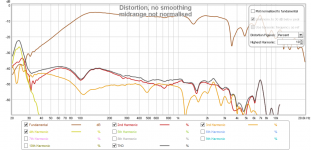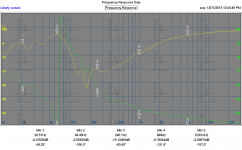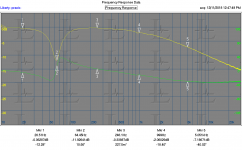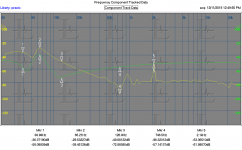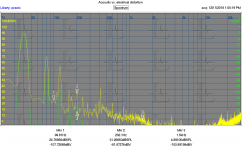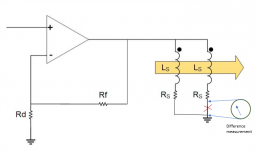It might have been a smaller midrange as well.
Bruno is using a DSP feedback LF filters to reduce distortion at very low frequencies, better say to reduce acoustically irrelevant large motion excited by LF transients or very low tones.
P.S.: 5" cheap midrange attached.
Bruno is using a DSP feedback LF filters to reduce distortion at very low frequencies, better say to reduce acoustically irrelevant large motion excited by LF transients or very low tones.
P.S.: 5" cheap midrange attached.
Attachments
Last edited:
Klippel in his active reduction paper mentions a 5 inch driver as well.
However, in the text, he talks about 20% reduced to 1-3%.
In your graphs, how is your machine calculating percentage? Looks like multiple harmonics exceed 100%.
jn
However, in the text, he talks about 20% reduced to 1-3%.
In your graphs, how is your machine calculating percentage? Looks like multiple harmonics exceed 100%.
jn
In your graphs, how is your machine calculating percentage? Looks like multiple harmonics exceed 100%.
jn
It was set to relate to "Plot normalised to fundamental". So if the fundamental is low (you are below resonance), harmonics are higher than fundamental. The second option how to plot is in dB without normalisation - attached. It is all about a switch in our head.
Attachments
The figures in the bottom of that window relates to where the cursor is placed. There is an option to show the cursor in the Capture function which seem not to have ben chosen. One can just read the levels in the diagram and ignore the bottom info.
When 2nd exceeds fundamental I suppose you get more than 100% 🙂
//
When 2nd exceeds fundamental I suppose you get more than 100% 🙂
//
Without that pop up saying normalize to fundamental, how would I know?
Remember, you have to limit your use of multisyllabic words if you expect me to understand.. 😉
So the Klippel graphs are normalized to fundamental, good to know.
Jn
Remember, you have to limit your use of multisyllabic words if you expect me to understand.. 😉
So the Klippel graphs are normalized to fundamental, good to know.
Jn
Some more data. These were measured at 1V no box. First coupling from drive coil to open coil (as before at a higher level) Second difference between coils, plus connections tied together and to the amp, looking at ground to free end of open coil. Third HD2 and HD3 at 1V drive (HD2 is yellow, HD3 is green). Finally 40Hz difference signal distortion spectrum VS acoustical distortion spectrum (acoustic is yellow and electrical is green).
Attachments
4th picture...
The green is the result of an arithmetic operation (subtraction) between electrical distorsion in driven coil vs. in the none driven coil (open) - i.e. a difference signal?
//
The green is the result of an arithmetic operation (subtraction) between electrical distorsion in driven coil vs. in the none driven coil (open) - i.e. a difference signal?
//
Last edited:
4th picture...
The green is the result of an arithmetic operation (subtraction) between electrical distorsion in driven coil vs. in the none driven coil (open) - i.e. a difference signal?
//
I tweaked an illustration to show what I'm testing for clarity. I'm sure if I'm not measuring correctly someone will let me know.
Attachments
That is correct.I tweaked an illustration to show what I'm testing for clarity. I'm sure if I'm not measuring correctly someone will let me know.
The green is the fidelity of the voltage across the real component of the coil impedance.
Since the green harmonic information is going to be fed back to the summing node, and it is not consistent with the input signal, I am thinking that it will suppress the second and third harmonic of the acoustic.
Jn
Ps. I am hoping for at least 30 dB suppression of second and at least 20 dB on third.
If not, my theory is a bust.. 🙁
Last edited:
The figures in the bottom of that window relates to where the cursor is placed. There is an option to show the cursor in the Capture function which seem not to have ben chosen. One can just read the levels in the diagram and ignore the bottom info.
//
When I spoke about "obvious" yesterday I meant those readings belong to cursor position.
Last edited:
Now about LF distortion below resonance. I hope it is now obvious 🙂 that below resonance there is a huge cone extinction but almost no acoustical output. The cone moves out of its linear travel but does not radiate sound at fundamental. However, harmonics fall into frequency range where the speaker radiates acoustically. As the distortion is calculated as square root of sum of squared harmonics related to fundamental, it can exceed 100% as shown in the plot.
The cure is to predict large cone excursions below resonance and thus to reduce not only harmonics, but also inevitable intermodulations. This is now attempted by DSP and variable filters.
The cure is to predict large cone excursions below resonance and thus to reduce not only harmonics, but also inevitable intermodulations. This is now attempted by DSP and variable filters.
below resonance there is a huge cone extinction
Sorry, excursion.
--------
So, this is a SOTA, probably<
https://www.audioxpress.com/files/attachment/2609
Kii Audio Three active speaker review | What Hi-fi?
Last edited:
Thanks!
It's now clear. The gren trace is from the meter in the picture. It was the world "difference" that made me a bit uncertain. Nothing wrong with the measurement that I can see.
//
It's now clear. The gren trace is from the meter in the picture. It was the world "difference" that made me a bit uncertain. Nothing wrong with the measurement that I can see.
//
Last edited:
I haven´t heard the speakers, just read the review. From that, I speculate that they are "too perfect". What the reviewers are missing is probably the typical flaws in a monitoring chain (99% of the music was produced with imperfect monitors, and care is taken so that it "translates well" to the average home setup).
The Kii Controller has many practical advantages and gives a notable increase in clarity over even very good preamps like our reference Gamut D3i, but using it does result in a loss of natural warmth and body to the sound. Instruments and voices sound thinner and less convincing despite the extra cleanness of the presentation.
But regardless of whether the Controller is used or not, the Threes fall a little short in other areas too. While brilliant at defining the leading edges of notes, the speakers don’t render the texture of sounds as well as we like, nor do they convey dynamic nuances with great conviction.
The combination of these things means that Nina Simone doesn’t quite touch our soul, even with a song as affecting as Strange Fruit, while Debussy’s Claire De Lune lacks a little of its usual magical draw. Add an inability to get our feet moving to Michael Jackson’s Don’t Stop Till You Get Enough thanks to rhythmic precision that isn’t truly spot on, and you have a speakers that are dazzlingly easy to admire but not quite so easy to love.
A rather better review of the kii3 Kii Audio Three loudspeaker | Stereophile.com
Even 6 loons loved it 6moons audioreviews: Kii Three
Even 6 loons loved it 6moons audioreviews: Kii Three
Thanks Bill, however JA should learn how to correct for a baffle step in a near field part of the merged frequency response.
Another forum member posted some dual voice simulations back in 2010.
Dual Voice Coil Speed Feedback
Dual Voice Coil Speed Feedback
- Status
- Not open for further replies.
- Home
- Member Areas
- The Lounge
- John Curl's Blowtorch preamplifier part III

